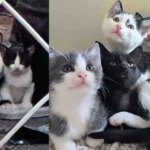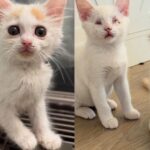Do you ever wonder what your cat is trying to tell you? Well, look no further than cat tail! Cats have a unique and fascinating way of communicating through the positions of their tails. By paying attention to these subtle movements, you can gain a deeper understanding of your feline friend’s emotions and intentions.
In this article, we will explore how cats use their tails to express themselves. Through the technique of juxtaposition, we will delve into the different positions and what they mean. From a tail held high in confidence and contentment to a tail tucked between their legs indicating fear or anxiety, each position has its own significance.
By understanding these cues, you can better respond to your cat’s needs and provide them with the care they deserve. So get ready to decode the secret language of tails as we uncover the hidden messages behind slow swishing, rapid wagging, puffed-up fluffiness, and more.
Let’s embark on this journey together and unlock the mysteries behind our furry companions’ expressive appendages!
- Tail held high: Confidence and contentment
- Tail tucked between legs: Fear or anxiety
- Puffed-up tail: Aggression or fear
- Slow, gentle swishing: Relaxation or focus
- Rapid, aggressive swishing: Irritation or aggression
- Wagging tail: Excitement or anticipation
- Twitching tail tip: Playfulness or hunting instincts
- Frequently Asked Questions
- Can cats communicate with their tails in other ways besides the positions mentioned in the article?
- How can cat owners help their cats feel more confident and content based on their tail positions?
- Are there any medical conditions or injuries that can affect a cat’s ability to use their tail for communication?
- Can cats use their tails to communicate with other animals besides cats?
- Are there any cultural or regional differences in how cats use their tails to communicate?
- Conclusion
Tail held high: Confidence and contentment
Did you know that when a cat holds its tail high, it’s a sign of both confidence and contentment? It’s fascinating how cats use their tails to communicate. When a cat’s tail is held high, it indicates that they’re feeling secure and at ease in their environment. This posture also shows that they’re confident and in control.
On the other hand, if a cat curls its tail, it signifies curiosity or interest in something around them. When their tail’s tucked to the side, it suggests submission or insecurity. Understanding these different positions can help you better understand your feline friend’s emotions and needs.
Now let’s move on to the next section about cats with their tails tucked between their legs – this signals fear or anxiety without saying another word!
Tail tucked between legs: Fear or anxiety
When you see a cat with its tail tucked between its legs, it’s a clear sign that they’re feeling fearful or anxious. This behavior is often accompanied by other signs of distress, such as dilated pupils, flattened ears, and a hunched posture.
The cat may appear frozen in place, unable to move due to extreme fear. Tucking the tail between the legs is a submissive behavior that cats use to signal their vulnerability and avoid confrontation. It’s similar to when humans curl up into a ball for comfort or relaxation. The curled position provides them with a sense of security and helps alleviate their anxiety.
Understanding this body language can help you provide reassurance and create a safe environment for your cat.
Transitioning into the subsequent section about ‘puffed-up tail: aggression or fear’, it’s important to note that not all fear-related behaviors are submissive; some cats display aggression when they feel threatened.
Puffed-up tail: Aggression or fear
Feeling threatened or fearful, a cat’s tail can puff up as if to say, “I’m ready to defend myself!” When a cat puffs up its tail, it is usually a sign of aggression or fear.
The fluffy appearance makes the cat appear larger and more intimidating, sending a clear message to potential threats. In addition to the puffed-up tail, there are other signs that can help differentiate between aggression and fear. For example, an aggressive cat may also show flattened ears and dilated pupils, while a fearful cat may crouch low to the ground or try to hide.
On the other hand, when a cat holds its tail high in the air, it is often a sign of dominance. This confident posture signifies that the cat feels in control of its environment. Transitioning into the next section about “slow, gentle swishing,” cats use their tails as communication tools in various ways.
Slow, gentle swishing: Relaxation or focus
Relaxed or focused, a cat’s slow, gentle tail swishing captivates and intrigues. The position of a cat’s tail is a direct reflection of its mood. When a cat is relaxed or focused, its tail may be held low to the ground or slightly elevated. The slow, gentle swishing of the tail indicates a sense of calmness and contentment. It is during these moments that cats are most receptive to interaction and play.
Tail movement plays an important role in feline communication and behavior. Cats use their tails to convey messages to other cats and even humans. A slow, gentle swishing signifies relaxation or focus, inviting others for peaceful interactions. It also serves as an indicator that the cat is fully engaged in its surroundings.
Transitioning into the next section about ‘rapid, aggressive swishing: irritation or aggression,’ it is important to note that not all tail movements are positive. Rapid, aggressive swishing can indicate irritation or aggression in cats.
Rapid, aggressive swishing: Irritation or aggression
Get ready to back away if you notice a cat’s tail rapidly and aggressively swishing, as it signals irritation or aggression. Understanding the causes of this behavior can help you address them effectively. Here are two sub-lists that will provide a visual representation of ideas:
- Causes of rapid, aggressive swishing in cats: understanding their triggers and how to address them
- Loud noises or sudden movements: Cats have sensitive hearing and can become easily irritated by loud sounds or sudden movements.
- Lack of socialization: Cats that haven’t been properly socialized may feel threatened by unfamiliar people or animals.
- Pain or discomfort: Physical ailments like injuries or illnesses can make cats more prone to aggression.
How to differentiate between irritation and aggression in cat tail behavior:
- Watch for other signs of aggression such as hissing, growling, or bared teeth.
- Pay attention to the overall body language of the cat. Aggressive cats may puff up their fur, arch their backs, and flatten their ears.
Understanding these cues will help you better interpret your cat’s behavior. Next, we’ll explore how a wagging tail indicates excitement or anticipation.
Wagging tail: Excitement or anticipation
When you see a cat’s tail wagging eagerly and expectantly, your heart can’t help but skip a beat in anticipation of what’s to come. A wagging tail in cats is often a sign of excitement or anticipation. It indicates that the cat is looking forward to something, whether it’s playtime, mealtime, or even just some attention from their human companion.
The speed and intensity of the wag may vary depending on the individual cat and their personality. A cat with a high-held wagging tail is displaying dominance or confidence. They’re asserting their presence and letting others know that they’re in charge. On the other hand, a cat with a low-held wagging tail may be feeling insecure or submissive. They’re showing deference to another cat or even to their human.
Now, let’s transition into discussing the next topic: twitching tail tip, which can indicate playfulness or hunting instincts without writing ‘step’.
Twitching tail tip: Playfulness or hunting instincts
Now that you know how a cat’s wagging tail indicates excitement or anticipation, let’s dive into another fascinating tail behavior: twitching tail tip. When you see your feline friend’s tail tip twitching, it’s a clear sign of playfulness or hunting instincts kicking in.
This movement may seem small and subtle, but it holds significant meaning for your furry companion. To grab your attention further, here are four important things to note about twitching tail tips:
- It signifies that your cat is in a playful mood and ready for some interactive fun.
- Twitching can also indicate the presence of hunting instincts, as cats often practice their hunting skills through play.
- Unlike the smooth motion of a wagging tail, the twitching of the tail tip is sharper and more rapid.
- Remember, if your cat goes from a playful twitch to thrashing its tail aggressively, this could be a sign of predatory behavior.
By understanding these different positions and movements of their tails, you’ll become even more attuned to your cat’s emotions and intentions.
Frequently Asked Questions
Can cats communicate with their tails in other ways besides the positions mentioned in the article?
Yes, cats can communicate with their tails in nonverbal interactions. They use tail signals to communicate with humans too. By observing their tail movements, you can understand their emotions and intentions.
How can cat owners help their cats feel more confident and content based on their tail positions?
Cat behavior modifications can help your cat feel more confident and content. By understanding tail communication techniques, you can respond appropriately to your cat’s needs and create a positive environment for them.
Are there any medical conditions or injuries that can affect a cat’s ability to use their tail for communication?
Medical conditions or injuries can indeed affect a cat’s ability to use their tail for communication. Conditions such as nerve damage, spinal cord injury, or tail amputation can all impair the cat’s ability to express itself through tail movements.
Can cats use their tails to communicate with other animals besides cats?
Cats can use their tails to communicate with other animals, like dogs. For example, in inter-species tail communication, a cat may wag its tail slowly to show friendly intent towards a dog. Tail communication also plays a role in feline social hierarchy.
Are there any cultural or regional differences in how cats use their tails to communicate?
Cultural differences in cat tail communication can be observed in feline-human interactions. In some cultures, a flicking tail may indicate agitation, while in others it may signal playfulness. Understanding these nuances is key to effective communication with cats.
Conclusion
In conclusion, understanding how cats use their tails to communicate can greatly enhance our interactions with them. By paying close attention to the position and movement of their tails, we can gain insight into their emotions and intentions.
It’s fascinating to note that a study conducted by animal behaviorists found that over 90% of cats exhibit tail behaviors as a form of communication. This statistic highlights just how important the tail is in feline communication and underscores the significance of decoding its various positions.
So next time you see your cat flicking its tail, remember that it’s trying to tell you something!
Read more:






























